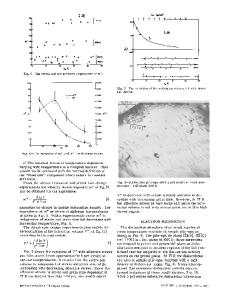Effects of Degree of Deformation and Deformation Temperature on Primary Recrystallization Textures in Polycrystalline Ni
- PDF / 682,479 Bytes
- 10 Pages / 593.972 x 792 pts Page_size
- 100 Downloads / 340 Views
ODUCTION
THE cube texture, i.e., {001}, is a major primary recrystallization component in many fcc metals. The origin of this texture has long been debated, with discussions focused on two alternative models, oriented growth and oriented nucleation.[1–3] According to the oriented growth model, the growth of cube grains is dominant because they have the maximum boundary mobility with respect to the major rolling texture components. In the oriented nucleation model, regions in the rolled matrix with cube orientation are favorable nuclei of new grains. There has been considerable recent interest in the production of nickel strips or tapes with sharp cube textures as substrates for growing high-temperature YBCO superconductors.[6–10] Such texture control of the nickel substrate and, hence, of the sputter-deposited superconducting oxides has allowed the production of polycrystalline tapes with {001} textures that contain mainly low-angle boundaries. The critical current densities of such textured tapes are significantly higher than those in randomly oriented polycrystalline material. A previous study[4,5] on the directional recrystallization of 90 pct cold-rolled, 99.5 wt pct purity, polycrystalline nickel suggested that a strong primary recrystallization texture—for nickel, the cube texH. CHANG, formerly Ph.D. Student, was with the Thayer School of Engineering, Dartmouth College, Hanover, NH 03755, USA, is Quality Engineer with the Materials Science for Continental Teves, Morganton, NC, USA. I. BAKER, Professor of Engineering, is with the Thayer School of Engineering, Dartmouth College, Hanover, NH 03755, USA. Contact e-mail: [email protected] Manuscript submitted January 10, 2007. Article published online September 29, 2007 METALLURGICAL AND MATERIALS TRANSACTIONS A
ture—is necessary for growing single crystals or columnar grains upon directional annealing at secondary recrystallization temperatures. The growth mechanism of the columnar grains or single crystals was also discussed.[5] There are a variety of factors including deformation temperature, degree of deformation, and annealing temperature that affect the deformation and recrystallization behavior of nickel. In this article, we present the results of an investigation into the effects of both the degree of deformation and the deformation temperature on the deformation texture, stored energy of deformation, recrystallization kinetics, and recrystallization textures of high-purity nickel.
II.
EXPERIMENTAL METHODS
Polycrystalline nickel of 99.995 wt pct purity was purchased from Alfa Aesar (Ward Hill, MA) in the form of 12-mm-diameter rods. The major impurities were 24 ppm C, 34 ppm Fe, and 2 ppm S. The microstructure of the as-received nickel is shown in Figure 1. Both the cross section (Figure 1(a)) and the longitudinal section (Figure 1(b)) of the material showed a nonuniform microstructure composed of a mixture of small (~20 lm) and large (£100 lm) grains. The {100} pole figure from the cross section (X-Y plane) of the nickel in its asreceived state is sh
Data Loading...










